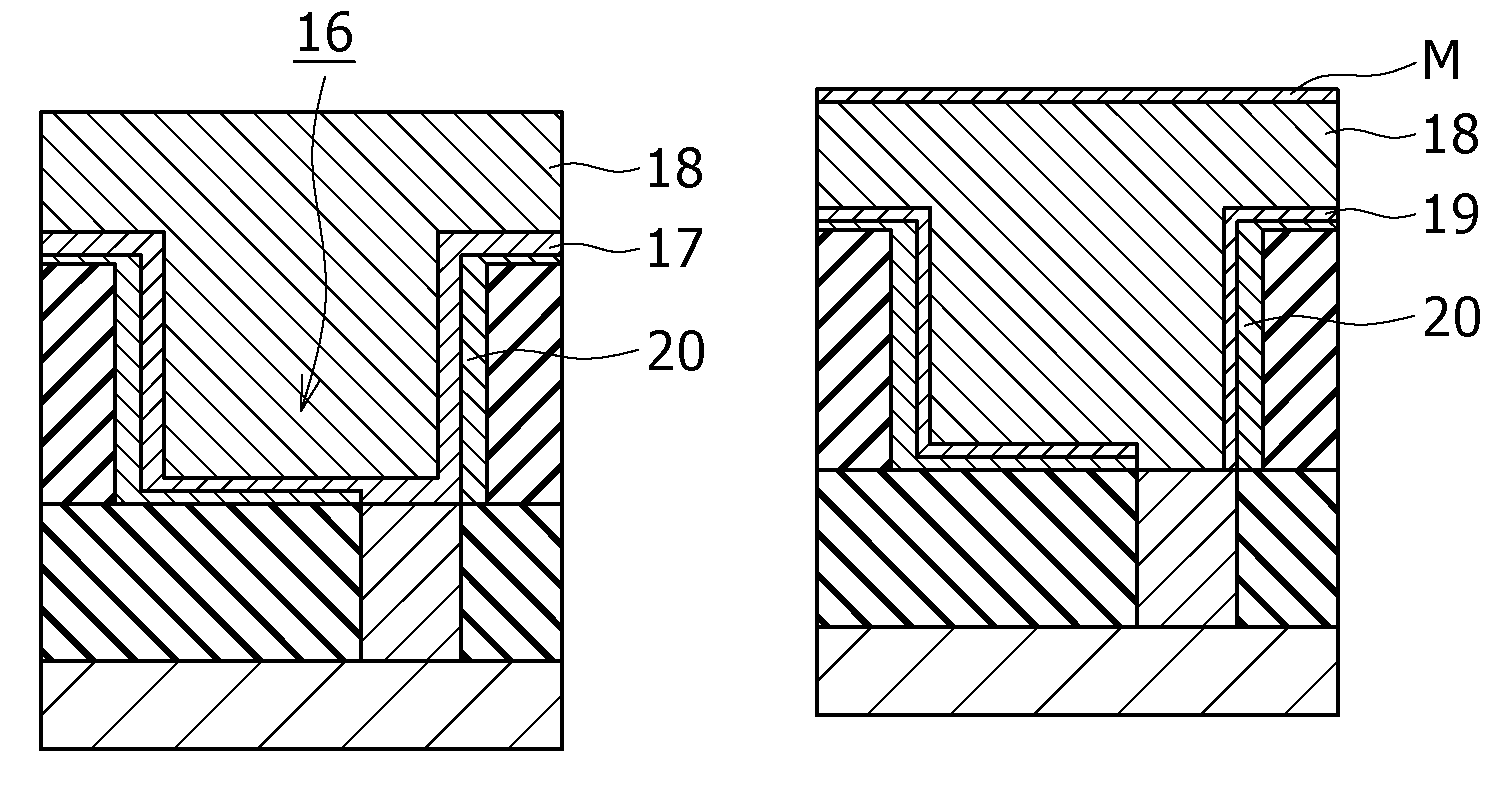Method for manufacturing a semiconductor device and semiconductor device
a manufacturing method and technology for semiconductor devices, applied in semiconductor devices, semiconductor/solid-state device details, electrical devices, etc., can solve the problems of conductive layer b>18/b> being liable to come off or separate, increasing wiring resistance, and burdening the process, so as to facilitate reaction, increase metal segregation sites, and surface roughness of insulating films at a sid
- Summary
- Abstract
- Description
- Claims
- Application Information
AI Technical Summary
Benefits of technology
Problems solved by technology
Method used
Image
Examples
first embodiment
[0032]This embodiment is an example embodying a manufacturing method of a semiconductor device according to an embodiment of the present invention and relates to formation of a single damascene wiring structure. A first embodiment of the invention is illustrated with reference to the sectional views of FIGS. 1A to 1F showing manufacturing steps, respectively. It is to be noted that like members or parts as in Description of the Related Art are indicated by like reference symbols.
[0033]As shown in FIG. 1A, a non-porous interlayer insulating film 12 made, for example, of SiO2 is formed on a substrate 11 constituted of a silicon wafer in which an element such as a transistor has been formed. Thereafter, a contact hole 13 arriving at the substrate 11 is formed and a via 14 made, for example, of W is formed as buried in the contact hole 13.
[0034]Next, a non-porous interlayer insulating film 15 made, for example, of SiO2 is formed in a thickness of 500 nm on the interlayer insulating film...
modification 1
(Modification 1)
[0056]Although the porous film 20 has been formed herein so as to cover the inner walls of the wiring groove 16 so that the wiring groove 16 is rendered porous at the inner wall side thereof to make a low density portion as is shown in FIG. 1B, the wiring groove 16 may be rendered low in density at a side of the inner walls thereof according to the following procedure.
[0057]As shown in FIG. 4A, a wiring groove 16 arriving at an interlayer insulating film 12 and a via 14 is formed in an interlayer insulating film 15. Next, the interlayer insulating films 12, 15 provided in the wiring groove 16 are subjected to plasma treatment, so that a modified layer 22 whose density is lower than the interlayer insulating films 12, 15 is formed at the inner wall side of the wiring groove 16. This modified layer 22 is increased in surface roughness over the non-porous interlayer insulating films 12, 15, for which when an alloy layer made of CuMn is formed on the modified layer 22 in...
second embodiment
[0067]A second embodiment relating to a manufacturing method of a semiconductor device according to an embodiment of the present invention is illustrated with reference to FIGS. 5A to 5L, each showing, in section, a manufacturing step of a semiconductor device. An instance of forming a dual damascene structure on the cap film illustrated with reference to FIG. 2 in the first embodiment is now described.
[0068]Initially, as shown in FIG. 5A, an interlayer insulating film 23 made, for example, of SiO2 is formed on the cap film 21, for example, by a PE-CVD method in a thickness of 700 nm. Although assuming herein that the interlayer insulating film 23 is formed of a single-layer film of SiO2, the interlayer insulating film 23 may have a hybrid structure wherein an organic insulating layer and an inorganic insulating layer are laminated.
[0069]Subsequently, a resist pattern (not shown) having a contact hole pattern is formed over the interlayer insulating film 23 and a contact hole 24a ar...
PUM
| Property | Measurement | Unit |
|---|---|---|
| density | aaaaa | aaaaa |
| thickness | aaaaa | aaaaa |
| thickness | aaaaa | aaaaa |
Abstract
Description
Claims
Application Information
 Login to View More
Login to View More - R&D
- Intellectual Property
- Life Sciences
- Materials
- Tech Scout
- Unparalleled Data Quality
- Higher Quality Content
- 60% Fewer Hallucinations
Browse by: Latest US Patents, China's latest patents, Technical Efficacy Thesaurus, Application Domain, Technology Topic, Popular Technical Reports.
© 2025 PatSnap. All rights reserved.Legal|Privacy policy|Modern Slavery Act Transparency Statement|Sitemap|About US| Contact US: help@patsnap.com



